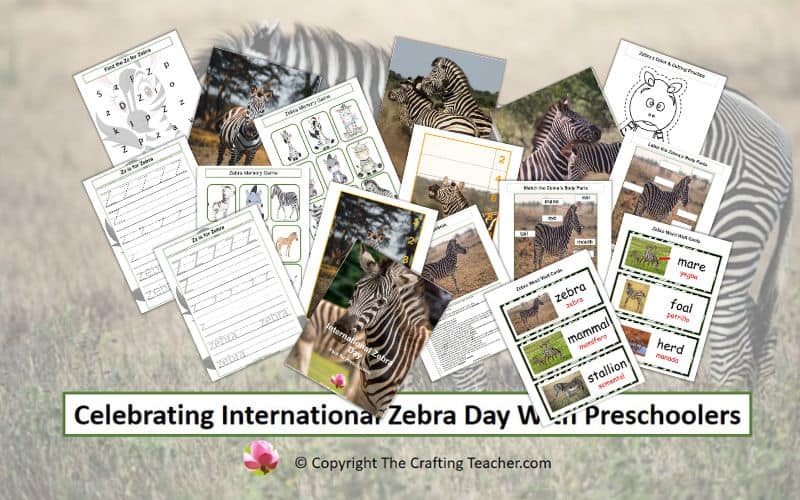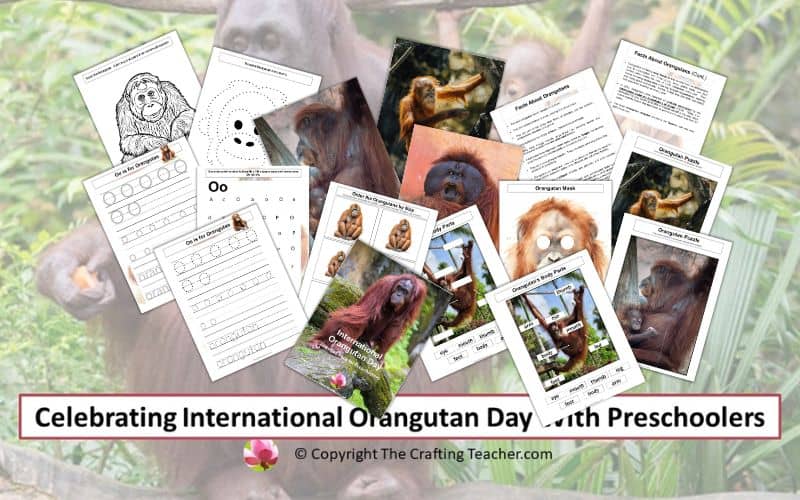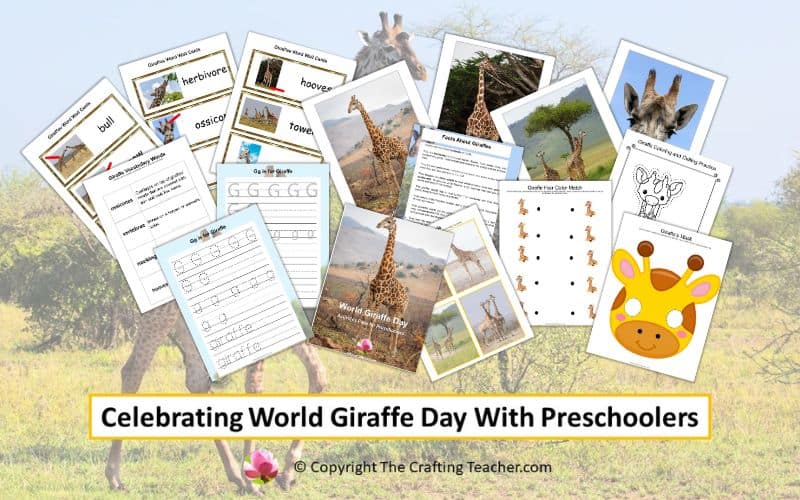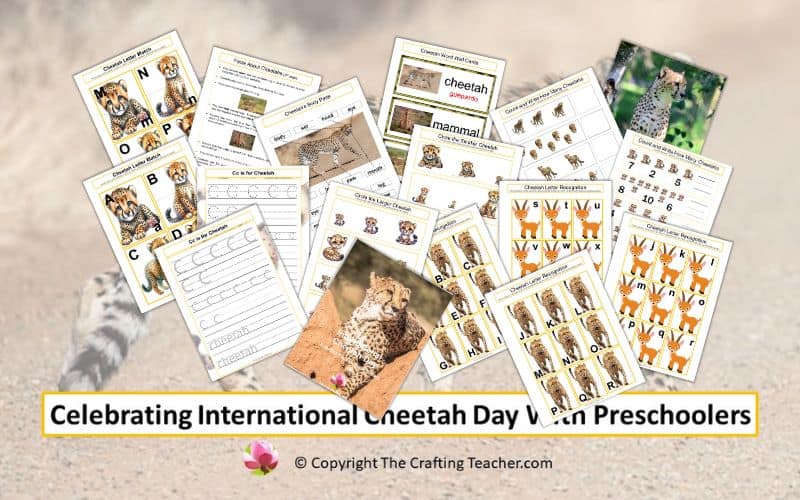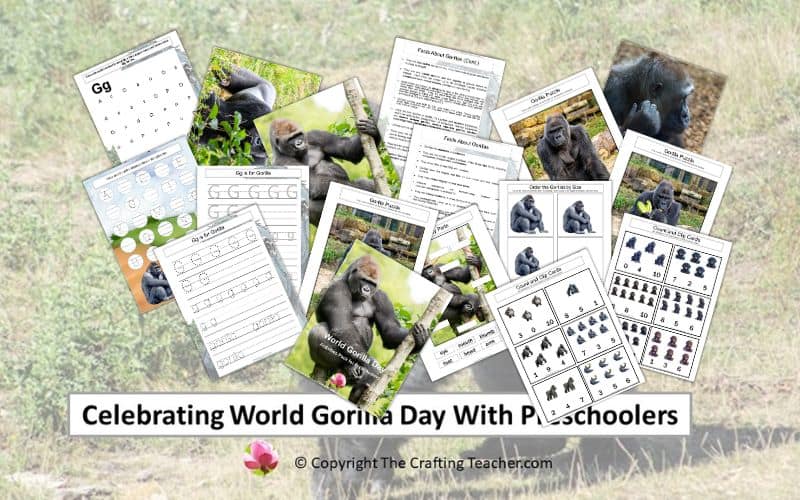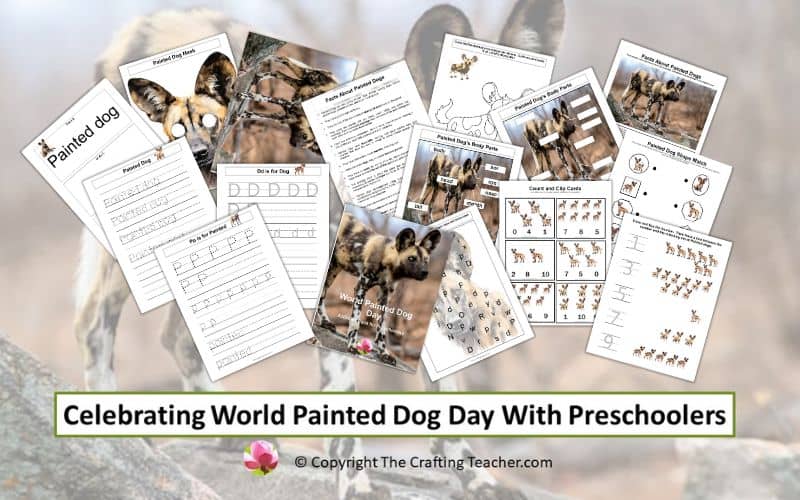Celebrating International Zebra Day with Preschoolers
Affiliate Disclosure: “This post contains affiliate links, which means I receive a small commission, at no extra cost to you, if you make a purchase using those links.”
International Zebra Day is celebrated every year on January 31 to raise awareness of the precarious situation that zebras are suffering, putting them at risk of extinction, and to encourage people and governments to participate in conservation efforts to protect these mammals and guarantee their long-term survival.
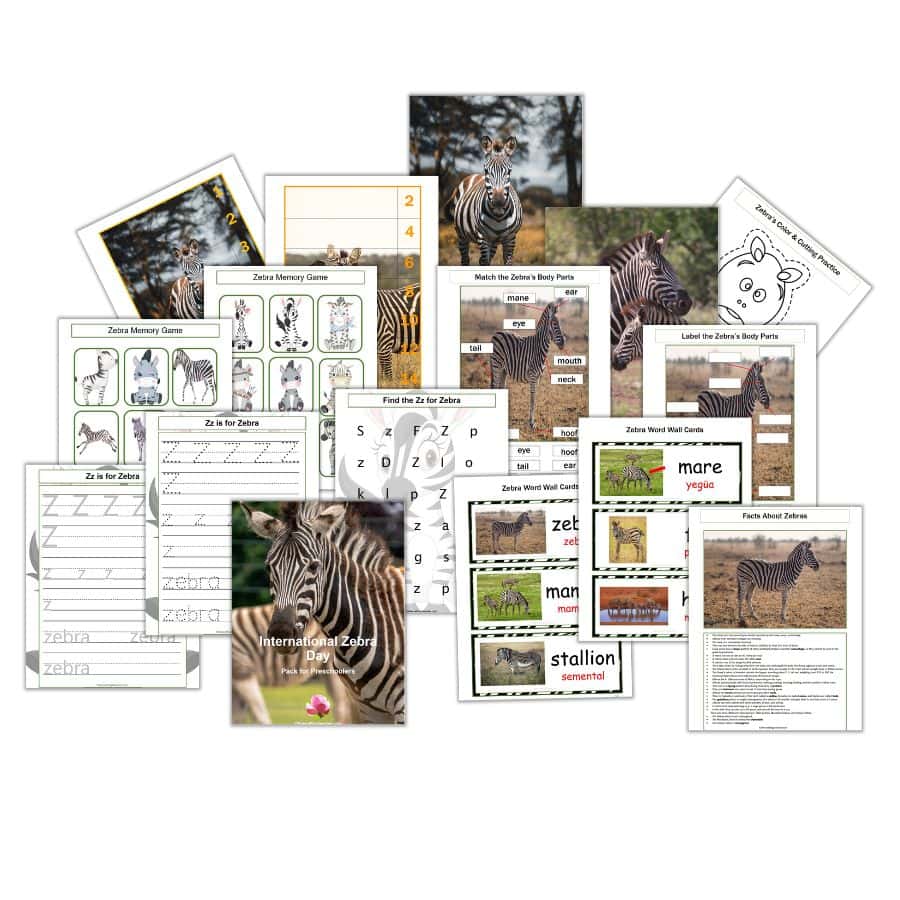
I have included a FREE 21-page International Zebra Day Pack for your preschoolers. The pack provides literacy, science, math, and fine motor activities. It can be downloaded at the end of this post.
Importance of International Zebra Day
It is believed that this day was created by the Conservation Biology Institute, the Smithsonian’s National Zoo, and other conservation organizations to prevent more decline in zebra populations and increase their numbers.
The importance of the international zebra day is that makes people think about these animals, with positive consequences such as:
- Encourage more people to participate in the conservation efforts that different organizations are doing to preserve and increase the zebra population and ensure their well-being.
- It allows people to do something about it through awareness programs and gathering donations that might otherwise be impossible.
- Increase the possibility of a peaceful co-existence with zebras, other wild species, and humans without fighting for resources.
- Restore the ecological balance worldwide to ensure this planet’s and its inhabitants’ survival.
Some of the organizations protecting zebras are:
- Grevy’s Zebra Trust – a Kenya-based organization that works with local communities to protect the endangered Grevy’s zebra.
- International Fund for Animal Welfare (IFAW) – helps protect endangered species worldwide, including zebras.
- World Wildlife Fund – offers symbolic zebra adoptions to help save this endangered species, protect their ecosystems, and create harmony between people and nature.
- African Wildlife Foundation (AWF) – works to protect Africa’s species, including the Grevy’s zebra.
- Wildlife Conservation Society (WCS) – working to save wildlife and wildlife worldwide.
General Facts About Zebras
- Zebras are mammals, and belong to the Equus family, the same equine family as horses and donkeys.
- They have a distinctive coat with black and white stripes unique to each zebra, just like fingerprints, and help them camouflage.
- Depending on the species, zebras have from 25 to 80 stripes on their bodies.
- Their black stripes contain melanin, which protects them from the sun’s UV rays and warms them up in the morning. The white stripes reflect the light, helping them cool down their body temperature.
- Zebras’ skin is black or dark brown.
- They have perfect wide-field eyesight and can spot movement at great distances.
- They have long faces and necks and barrel-shaped chests.
- Their legs are long and slender with hoofed feet and capable of powerful kicks and powerful bites.
- They communicate with each other, moving their bodies and ears and using facial expressions.
- Zebras are herbivores and eat different grasses, leaves, and stems.
- Since they are always grinding their food, zebras’ back teeth constantly grow their entire lives.
- They are fast runners and can reach up to 40 miles per hour.
- They are found in Kenya, Ethiopia, Namibia, Angola, and South Africa.
- They travel great distances to find food and water during the dry season.
- They are very social and live in groups called herds or dazzles.
- A male zebra is called a stallion responsible for leading and protecting the herd.
- A female zebra is called a mare, and a baby is called a foal.
- A foal can stand up six minutes after being born.
- They can sleep standing up by locking their knee joints or lying down.
- Foals are born with brown and white stripes or spots in some cases. The black and white stripes pattern appears as they grow.
- They live up to 25 years in the wild and 30 years in captivity.
- There are three species: the Plain Zebra, the Mountain Zebra, and the Grévy Zebra.
- Zebra populations are threatened due to the introduction of livestock competing for grazing land, poaching for their coats, killed for food and medicinal uses in some regions.
- Plain zebras are classified by the IUCN Red List as threatened.
- The mountain zebra is classified as vulnerable by the IUCN Red List.
- The Grévyzebra is considered endangered on the IUCN Red List of Threatened Species.
Facts About the Plain Zebras
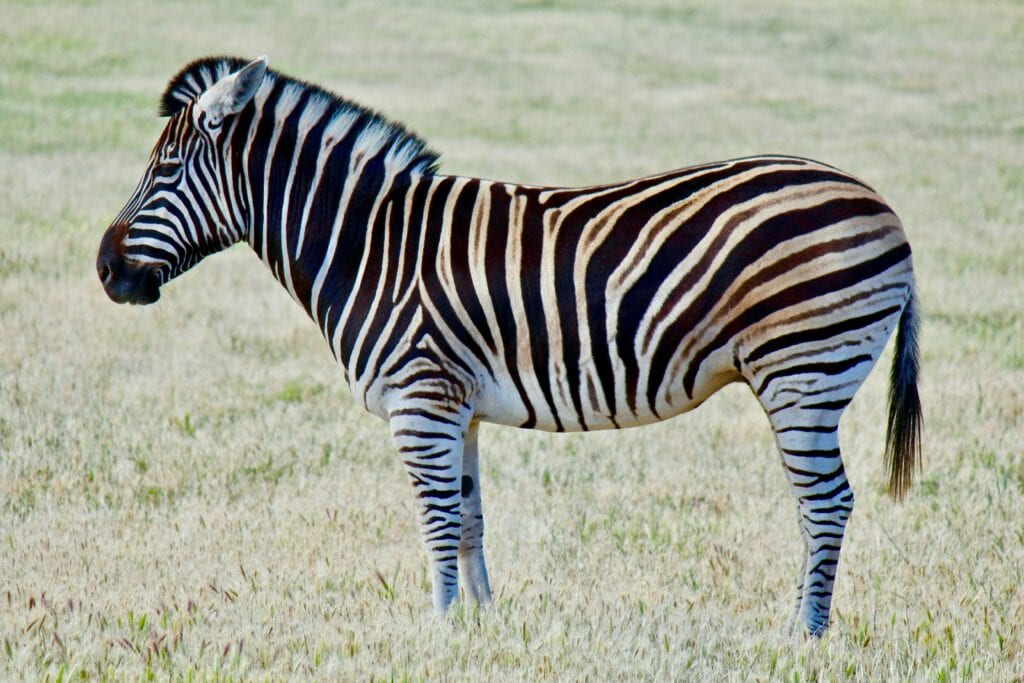
- The Plains zebras, the common zebras, are the most abundant of the three zebra species.
- They have a different stripe pattern than the other species, which includes their underbelly.
- They have broad stripes that run horizontally towards the back and vertically towards the front. They also have a stripe that runs down the center of their backs onto the tail.
- Their coat reflects more than 70% of the heat of the African sun.
- Plains zebras can run at around 63 kilometers per hour.
- They are smaller than the other two species of zebra. They measure from 3.5 to 5 feet in height and weigh up to 850 pounds.
- They are found in the grasslands of more than a dozen countries in eastern and southern Africa, including Botswana, Ethiopia, Zimbabwe, and South Sudan.
- They usually have one foal at any time of the year.
- According to the IUCN’s Red List of Threatened Species, the plains zebra are threatened.
Facts About Mountain Zebras
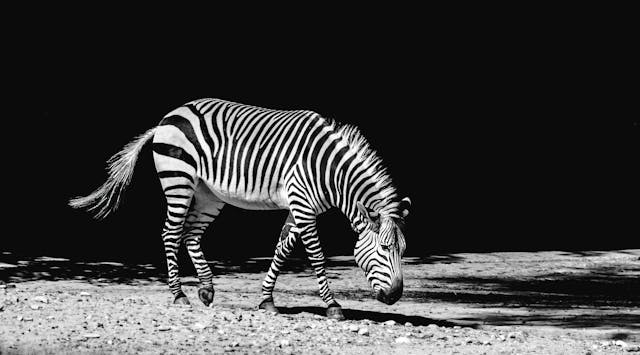
- Mountain zebras have white or off-white bodies with black or dark brown stripes that are closely spaced.
- Their heads, torsos, and rumps are usually not striped, and the stripes on their bodies are thinner than those on their bellies.
- Hartmann’s mountain zebra is a subspecies with black and white vertical stripes on their neck and torso and horizontal stripes on their backside. They also have white, non-striped bellies.
- They are crepuscular and rest and graze during the day.
- Mountain zebras are found in a few dry, rocky slopes and semi-wooded grasslands of Angola and Namibia.
- The mountain zebra is classified by the IUCN as vulnerable, with an increasing population trend.
Facts About the Grévy Zebra
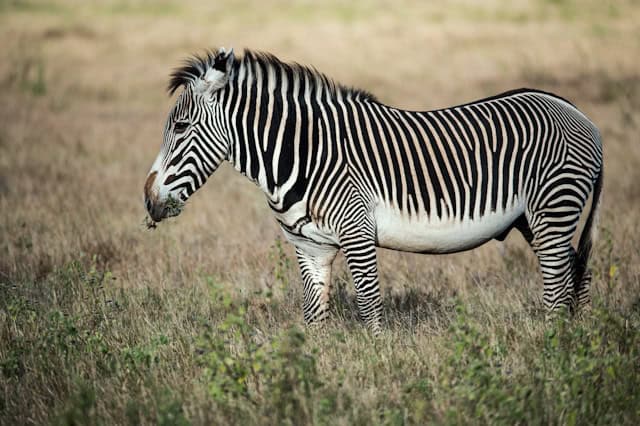
- The Grévy zebra is the largest of the three zebra species.
- They have 80 or more thinner stripes than the stripes in the other two species and run down their white belly and rump.
- Their mains are tall and erect, and their ears are more prominent than any other zebra species, with thick fur inside.
- Their necks are long, and their heads are narrow.
- They can grow up to 5 feet and weigh between 780 and 950 pounds.
- They can run at a speed of up to 40 miles per hour.
- They are only found in semi-arid scrub and grasslands of Southern Ethiopia and Northern Kenya.
- They often share their grazing lands with wildebeest, ostriches, antelopes, and other grazing animals.
- They spend over half their day eating grasses, bark, fruit, and leaves.
- They are water-dependent and won’t travel far from a water source.
- They are temperamental, aggressive, and stubborn, making them almost impossible to tame.
- They don’t form long-lasting bonds between adults. Mares and foals can work in small groups without hierarchies or long-lasting structures.
- Two to six stallions also can get together without a leader.
- Their main predators are lions, cheetahs, hyenas, hunting dogs, leopards, and people.
- Their population has suffered one of the most substantial reductions of any African mammal. These zebras are considered endangered by the IUCN because there are only about 2800 left in the world.
How to Celebrate the International Zebra Day
- One excellent way for parents and teachers to celebrate International Zebra Day is by learning fascinating facts about these amazing mammals and sharing what they learned.
- Dress in black and white stripes to attend school or work, and invite your preschoolers to do the same.
- Organize fundraising to collect and donate funds to organizations that protect zebras, such as the World Wildlife Fund (WWF), the Wildlife Conservation Society (WCS), the Grevy’s Zebra Trust, and the African Wildlife Foundation.
- Talk about International Zebra Day on your social media accounts to spread the word about protecting zebras, and maybe include a selfie in that zebra outfit.
- Read books about zebras to your preschoolers, and invite your families to do the same.
Books About Zebras
These are some of my favorite books about zebras. If you don’t have any available, you can go to your local library or a used bookstore or use my links on the titles to get them from Amazon quickly. Get as many as possible, read them to your preschoolers, and fill your library and centers.
- A Zebra’s Day by Aubrey Andrus will teach children about where they live, what they eat, and how they survive in the herd, using simple text and engaging photos.
- Zebras! by Hope Aicher celebrates the beauty and wonder of the zebra world with collections of full-color photos and fun, interesting facts.
- Zed the Zebra: First Day Nerves by Ryan Scott uses rhyme packed with fun and relatable characters, clever coping tools like deep breathing and positive thinking, and encouraging messages about friendship, bravery, and trying new things.
- Zebras and Their Secrets by Joanna Slodownik is an engaging and beautifully illustrated book that explores the lives of zebras, from their unique stripe patterns to their social behaviors and habitats, in vivid detail.
- Zebra and Horse by This engaging story follows a proud horse and a playful zebra as they learn the importance of friendship, kindness, and acceptance.
- Zoe Zebra Loses Her Z by Christina McDonald will introduce your child to the alphabet through repetition and rhymes, using vibrant pictures and funny poems.
- The Zebra Says Shhh by M.R. Nelson tells the story of an exhausted zebra that wants to sleep while the other animals at the zoo still want to play.
- How the Zebra Got Its Stripes by Justine Fontes is a colorful, informative book that includes fun facts explaining why zebras have stripes.
Pin It For Later
If you are in a rush and don’t have time to read the post and download the printable but want to save it, pin it to one of your Pinterest boards for later.

Thanks to our actions, zebras and many other species are in danger of extinction. Our responsibility is to do something about it to protect the vast diversity of our planet, including ourselves.
This is the time for us to take action, teach our future generations to love nature, encourage them to protect life in general, and become conservationists for life.
I hope you enjoy these ideas and that they help you have fun with your preschoolers during the International Zebra Day celebration. To get the FREE pack, click on the link below and enter your information for an immediate download.
Be happy, safe, and creative. I wish you well.
Love,

P.D. Please let me know if any of these ideas worked for you or if you think I need to add or replace something. My goal is to help you in any way I can, and I wouldn’t say I like anything better than to post something that you might find helpful.

